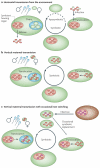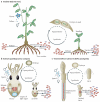A complex journey: transmission of microbial symbionts
- PMID: 20157340
- PMCID: PMC2967712
- DOI: 10.1038/nrmicro2262
A complex journey: transmission of microbial symbionts
Abstract
The perpetuation of symbioses through host generations relies on symbiont transmission. Horizontally transmitted symbionts are taken up from the environment anew by each host generation, and vertically transmitted symbionts are most often transferred through the female germ line. Mixed modes also exist. In this Review we describe the journey of symbionts from the initial contact to their final residence. We provide an overview of the molecular mechanisms that mediate symbiont attraction and accumulation, interpartner recognition and selection, as well as symbiont confrontation with the host immune system. We also discuss how the two main transmission modes shape the evolution of the symbiotic partners.
Figures




References
-
- Ewald PW. Transmission modes and evolution of the parasitism-mutualism continuum. Ann. N. Y. Acad. Sci. 1987;503:295–306. - PubMed
-
- Yamamura N. Vertical transmission and evolution of mutualism from parasitism. Theor. Popul. Biol. 1993;44:95–109.
-
- Lipsitsch M, Siller S, Nowak MA. The evolution of virulence in pathogens with vertical and horizontal transmission. Evolution. 1996;50:1729–1741. - PubMed
-
- Yamamura N. Evolution of mutualistic symbiosis: a differential equation model. Res. Popul. Ecol. 1996;38:211–218.
-
- Genkai-Kato M, Yamamura N. Evolution of mutualistic symbiosis without vertical transmission. Theor. Popul. Biol. 1999;55:309–323. - PubMed
Publication types
MeSH terms
Grants and funding
LinkOut - more resources
Full Text Sources

